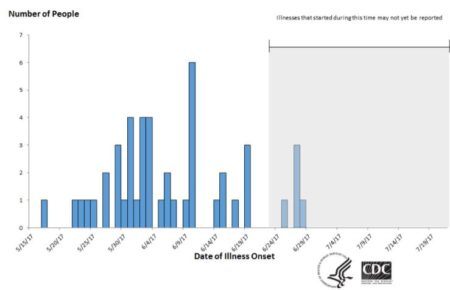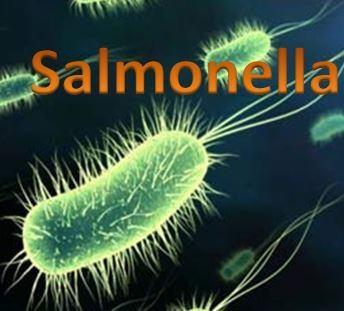Salmonella in Papaya Sickened 47 People in 12 States
Findings of the Papaya Outbreak
 An investigation of a multistate outbreak of Salmonella Kiambu has being conducted by the CDC, FDA and public health officials in several states. As of last Friday (7/21/17), 47 individuals from 12 states have been infected with Salmonella Kiambu, the outbreak strain.
An investigation of a multistate outbreak of Salmonella Kiambu has being conducted by the CDC, FDA and public health officials in several states. As of last Friday (7/21/17), 47 individuals from 12 states have been infected with Salmonella Kiambu, the outbreak strain.
Whole genomic sequencing (WGS) shows that the Salmonella Kiambu isolated from the infected people is genetically closely related, and therefore, are more likely to share the same source of infection.
More than third of the affected people were hospitalized, and one death was reported in New York City. The epidemic chart below shows the number of people who became ill each day. Illnesses that happened after June 23, 2017might not been reported yet because it takes 2-4 weeks for the data to be reported.

In Maryland, a cluster of illness was identified. Several ill people reported eating papayas purchased from the same grocery store. Epidemiologic and laboratory data indicated that yellow Maradol papayas were a likely source of this outbreak.
Among 58% of the people with available information, were of Hispanic ethnicity. 44% of sickened people interviewed reported eating papaya within days before the illness, significantly higher than Hispanics eating papaya in the general population (16%).
From the samples collected from ill people, Salmonella Kiambu and Salmonella Thompson was isolated. Clusters, like the one discovered in Maryland, provided a critical clue to the source of the outbreak, and as a result, the papaya was identified as the main source of the infection.
The Maryland Department of Health collected papayas at a Baltimore retail location and found 3 of the 5 yellow papayas that they tested confirmed to be contaminated with Salmonella. As a result, they warned the public not to buy Caribeña’s yellow Maradol papayas.
The majority of the cases occurred in New York (13) and New Jersey (12), followed by Virginia (6), Maryland (5), Pennsylvania (4) and a single case in Iowa, Kentucky, Louisiana, Massachusetts, Minnesota, Texas, and Utah.
The FDA s advising consumers not to eat Caribeña brand Maradol papayas because of their link to the Salmonella outbreak. Maradol papayas are green before they ripen and turn yellow, so consumers should not eat Caribeña brand regardless of the color.
According to the FDA, the distribution pattern of Caribeña brand Maradol papayas does not fully explain all of the illnesses. Therefore other firms might have distributed contaminated Maradol papayas as well. All the farms producing this type of papayas are only in Mexico.
Papaya as the Source of Past Salmonella Outbreak
Between May 12 and August 18, 2011, an investigation by CDC and the FDA, in collaboration with public health officials in Texas, Illinois, Georgia, and other states examining a multistate outbreak of Salmonella Agona infections linked to whole fresh papayas imported from Mexico.
A total of 106 individuals infected with the outbreak strain of Salmonella Agona were identified between January 1 and August 25, 2011, in 25 states. The states involved were: Arkansas (1), Arizona (4), California (8), Colorado (1), Georgia (8), Illinois (18), Indiana (1), Kentucky (1), Louisiana (2), Massachusetts (1), Minnesota (3), Missouri (3), Nebraska (2), Nevada (1), New Jersey (1), New Mexico (3), New York (9), Ohio (1), Oklahoma (1), Pennsylvania (2), Tennessee (1), Texas (25), Virginia (2), Washington (5), and Wisconsin (2). Ten patients were hospitalized, but no deaths were reported.
Epidemiological data, traceback investigations, and laboratory data linked this outbreak to eating fresh whole papayas imported from Mexico by Agromod Produce, Inc. of McAllen, Texas.
Of the ill people, 57% reported consuming papayas in the week before illness onset. This was significantly different compared with results from a survey of healthy people in which 11% of the Hispanic/Latino ethnicity and 3% of non-Hispanic/Latino ethnicity reported consuming papaya in the 7 days before they were interviewed.
The FDA investigation found two papaya samples contaminated with Salmonella Agona. The FDA’s evidence showed a widespread problem that prompted the FDA to issue a countrywide import alert for papayas from Mexico.
What Can Be Done?
Some Salmonella outbreaks in the recent past are due to fruits and vegetables. The outbreaks can be due to the ability of Salmonella to attach or internalize into fruits. Survival and multiplication of Salmonella on fresh fruits is considerably increased once the protective epidermal barrier has been broken either by physical damage due to punctures or bruising or by degradation by plant pathogens.
Environmental factors such as contaminated water used to irrigate and wash produce crops have been implicated in a large number of outbreaks. FSMA is designed to help minimize the risk of illness from foodborne pathogens in fresh fruits, and include requirements for water quality, employee hygiene, and equipment and tool sanitation. Hopefully, these new FSMA rules will be able to reduce Salmonella incidents in fresh fruits.
